Introduction: Japan was introduced the the idea of an ironclad very soon: Its spectacular defeats in face of Image result for korean admiral Yi Sun-sin, the Korean Admiral which deployed a few Geobukseon or “turtle boats” to win against a far superior force, was probably still not forgotten when Admiral Perry entered the bay of Yokohama and imposed, by gunpower, the opening of Japan to the exterior world in 1853. Introduction of ironclads in the burgeoning Imperial navy came during the Boshin war (1868-69), see the ships and events related to this era. The former CSS Sphynx, later CSS Stonewall, ordered in France, Arman Bros Shipyards in Bordeaux by the Confederate government in North America (American Civil war) was completed and already sailing on the other side of the Atlantic when news arrived of the Capitulation at Appomatox. On arrival, she ship was therefore seized by the Union and later put on sale, as the fleet did not needed any ironclad, going back to Monroe isolationist policy.
At the same time in 1865, the Boshin war was just started and the opposing forces of the Shogunate and Emperor ordered ships of their own. The Shogun had the recently available ironclad purchased in the US, and commissioned in 1867, but upon arrival, Imperial forces seized the ship. Its name was Kotetsu, or “iron covered ship”. (See later for the complete records of Adzuma). Also the history repeated when the Scottish shipyard of Aberdeen built an armoured corvette speculatively, given the international context. And soon, the Confederates showed interest, but ultimately they failed to produce the budget for it, and the war ended, leaving the vessel, launched in 1864, to the Yard. Sold on the open market, she was loaned eventually in 1869 by the Prince Hizen for the Emperor’s fleet (see later). The Kotetsu however was already in needs of maintenance and repairs upon arrival and her artillery was soon found obsolete. She was a bit too complex to operate for the Japanese in the 1860s and ended in reserve.
In 1874, the Japanese launched an expedition against Formosa pirates. It became evident a new navy was needed, and soon orders were secured after ratification by the parliament as situation also degenerated with Korea. These ships were all designed by Sir Edward Reed in UK, the Fuso, Kongo and Hiei. The first was a broadside ironclad, the others were armoured corvettes (see the boshin war and meiji era fleet).
Ironclads of the Boshin and Sino-Japanese war
We could distinguish two periods over which the Japanese acquired their capital ships: First one, Before the Russo-Japanese war (Part I), and after this war (part II). In the first case, these were “clones” of British Capital ships, and built in British yards, with British equipment and armaments, while crews and officers spent years of training with the Royal Navy. No wonder reports of the Russo-Japanese war were eagerly awaited by the top brass in the the Royal Navy and had huge consequence in warshiop design at the time. Both the ships and tactics had been put to good use by Admiral Togo definitively installing Japan as the regional superpower.
Not only the event surprised the world, shaking certitudes of the Westerners, but it also confirmed Japan in her ambitions in the Asian sphere and the Pacific. The confrontation of 1941 was already born from this confidence. But its also proved to the British Admiralty that her ships, training and tactics would have defeated the Russians in this proxy war, confirming their own confidence until it was shaken again by the battleship race with Imperial Germany. Meanwhile, the bond between the two navies lasted until Japan’s dreadnought race and the post-Tsushima approach of capital ship design and construction. Japan took time to pause (no capital ship was ordered before 1904), resuming work on two battleships leaning already towards the dreadnought with a powerful secondary battery, and the first proper dreadnought, Kawachi class. However Japan paused again mainly for economic reasons, before launching the ambitious 8-8 program FY1912 with four battlecruisers and a year after first battleship the Fuso class, a considerable leap forward in terms of armament and speed, leaning to the British “super-dradnoughts” of the time.
IJN Adzuma (1864)
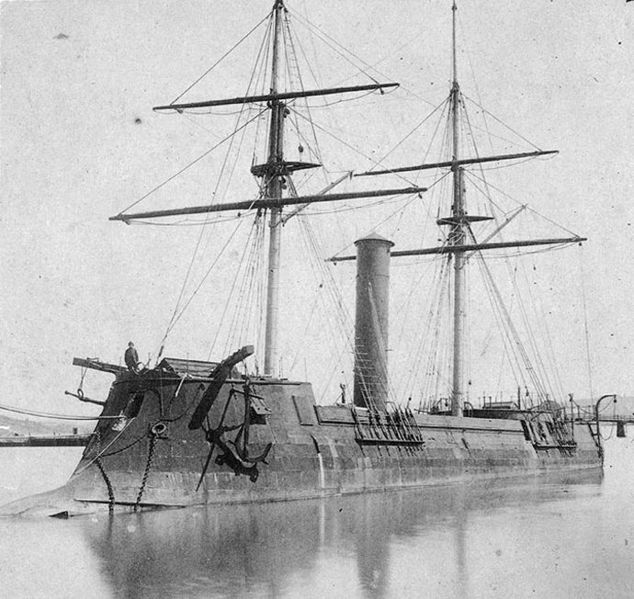
The “Kotetsu” as named upon arrival, became the flagship of the first Imperial Naval squadron, and her major battle was on 20 April 1869 when she sailed to attack with the fleet of the Shogunate Navy blockading Hakodate. This victory sealed the fate of the Shogunate and accelerated the end of the civil war.
Kotetsu, launched in June 1864 and completed in October of the same year, was an ironclad ram. Her main weapon was its reinforced ram, with a heavy gun installed above, of 300 pdr SB. It was from the Armstrong yard, just as the two secondary 70 rifled pdr guns installed aft, in a casemate located abaft the rear mast, fixed. The ship was indeed rigged as a brick. The ship had a composite hull protected by 3-1/2 inches iron plates bolted to 3 inches teak planes (75 mm thick), backed again by 1-1/4 inches iron plates again, a sandwich in which the wood absorbed the energy of any projectile, up to 15-inches. The ram projected some 20 feets in front of the stern, but the hull had a draught limitation of 14 feets for the Mississippi, making for a poor seaboat. She was top heavy and tended to plow through waves in a moderate sea. In 1871 she was renamed IJN Adzuma, ans was rearmed with more modern guns: A 9 inches Armstrong MLR by December, plus four Parrot 6.5 inches MLR which took place in the aft casemate, presumably in new mounts with some traverse. She was placed in reserved and stricken in 1888 and survived until 1908 as an utility hulk.
IJN Ryujo (1864)
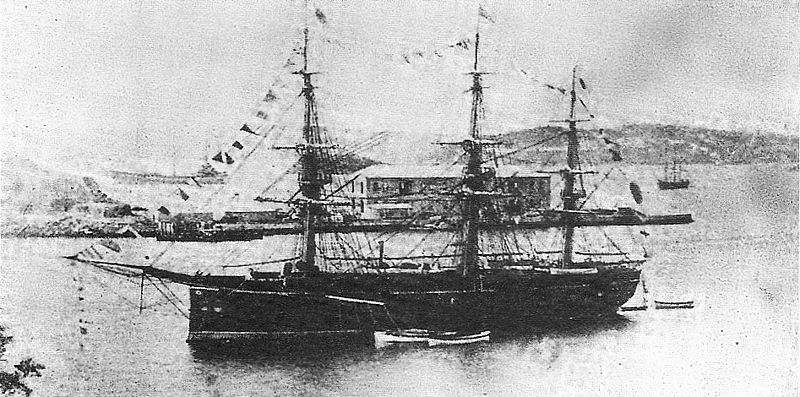
This broadside armoured corvette was eventually purchased by the Prince and presented to the Emperor as the war ended, in 1870. IJN Ryujo was larger than the Adzuma and better armed, but had no ram. Soon after her new commission she was rearmed with Krupp guns. Her original armament came from Armstrong, two 6.5 inches on traversible mounts and ten 5.5 inches on the broadside. Her new guns were 6.7 in Krupp BL. In 1894 she became a training ship, and rearmed with a 6-in Krupp and five 6.3 inches guns, discarded in 1898. So although she was available in 1894, she did not participated in the war.
IJN Kongo class (1877)
Two others were design by Reed and builder from 1875 at Earle’s Sb Co of Hull and Milfored Heaven of Pembroke. They were largely seen as British replicas to the Russian General Admiral, perhaps the first armoured cruiser, mixed with elements of HMS Gem. Kongo had a composite hull and Hiei, all iron. Both were rearmed, partially modernized and served at Yalu in 1894, the first Sino-Japanese war. Kongo also took part in the Hawaiian revolution of 1898, but both were reclassed as survey vessels and scrapped, after years as being used as utility hulks, in 1909 and 1911.
IJN Fuso (1877)
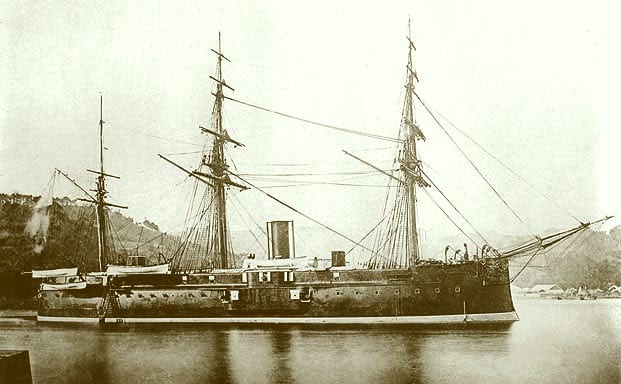
The first true ironclad of the Imperial Japanese Navy was IJN Fuso. She was ordered to prepare for a future war with China and Korea, at Samuda Bros. Poplar in UK, on a design prepared by Sir Edward Reed, as a smaller Iron Duke. She still displaced 3717 tonnes, barque-rigged with a machinery from Penn & Son of Greenwich, two pairs of CHSCT engines, 2 shafts reciprocating, 3932 ihp for 13 knots and 360 tonnes of coal carried, enough for a range of 4500 nm at 10 knots. Again, the Japanese ordered their guns to Krupp, in a layout which looked like on the French Redoutable. Four 4.9 inches, two 6.7 in, six 3-in, and one Nordenfelt 6-barrel QF MG. Her protection consisted in a 4 to 9 incjes main belt, 8-in battery and 7-in bulkheads. In 1894 as the war with China was coming, IJN Fuso was completely rebuilt and modernized. Her rigging was deleted and she kept military masts with tops of the fore and mizzen, mainmast removed; She received two new 6.7 in and two 6 in/50 guns, eleven 3-pdr QF guns and two 18-in TTs. Fuso participated in the battle of Yalu. She was damaged in 1897 during a collision with Matsushima, running aground on Shikoku, but was towed to Kure for repairs. She emerged in 1899 with her old 9.4 in BL removed and two 6-in QF, and one more 3-pdr. She became a coast defense ship in 1903 with just two 6-in/50 and four 4.7 in/40 QF, discarded in 1908 and scrapped.
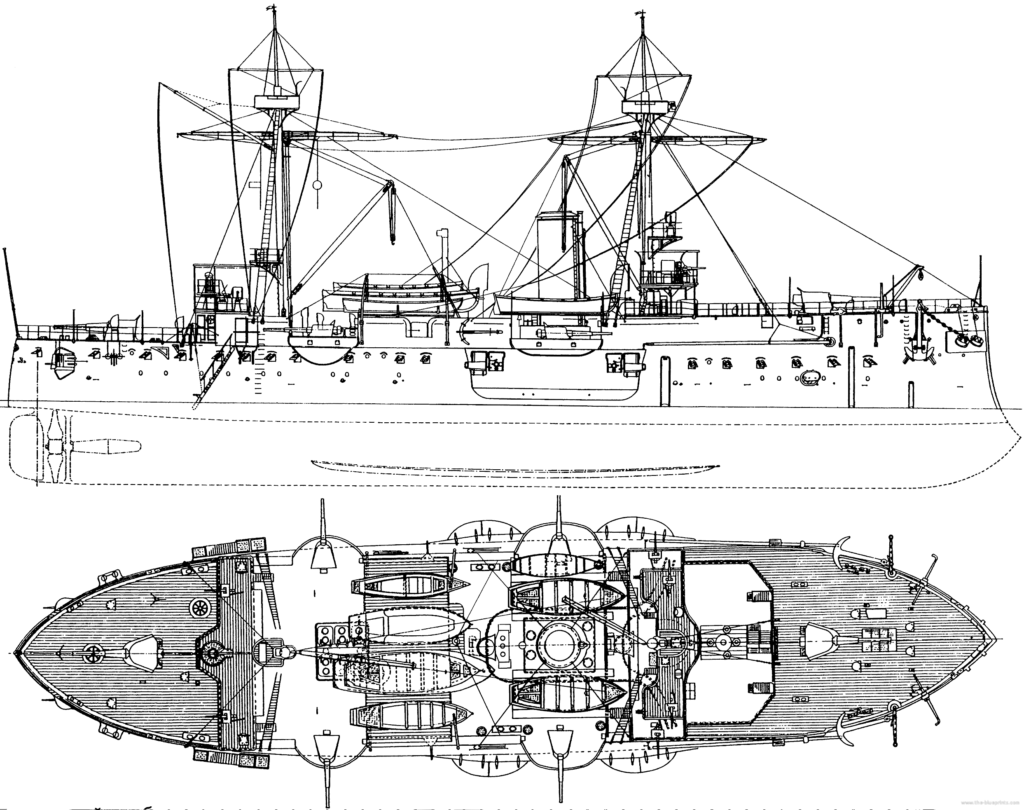
IJN Fuso, as modernized;
IJN pre-dreadnoughts of the Russo-Japanese war (1905)
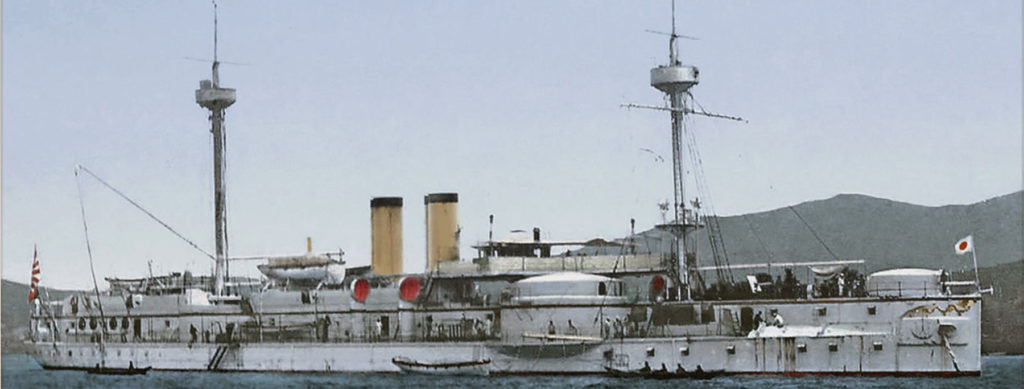
 Chin Yen (1882)
Chin Yen (1882)
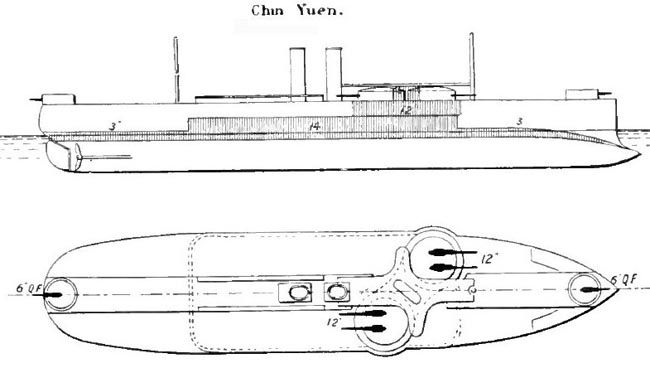
The Sino-Japanese war bring to the Japanese Navy its first modern ironclad, the German-built (Vulcan) Chin Yuen, captured at Wei-Hai-Wei in February 1895. This history has been well covered already in the dedicated post about the Dingyuan class battleships. Refitted and rearmed, Chin Yen was recommissioned as a flagship and did took part in the Russo-Japanese war, shelling port arthur, but was absent due to her speed at the battle of the Yellow sea. She was discarded in 1910, a training ship for pilots until scrapped in 1914.
 Hei(Ping) Yen (1890)
Hei(Ping) Yen (1890)
The second one was more modest, IJN Hei Yen. She was a Chinese built 1890 coast defence ironclad built at Foo Chou, displacing 2150 tonnes, 60.95 m long by 12.2 by 4.15 in draught, captured at Wei Hai wei. Her Krupp guns were removed and Armstrong guns installed instead, one 10.2-in (260 mm), two 6-in (152 mm) QF, eight 3-pdr (37 mm) and four 18-in TTs; She took part in the Russo-Japanese war as a coastal bombardment vessel, but was lost during the war, hitting a mine off Pigeon bay, Port Arthur.
But the real fulcrum of the IJN when war broke out in 1904 were two series of modern Battleships, British-built, the Fuji and Shikishima classes, Asahi and Mikasa. The later was brand new, completed in 1902. This war showed how much the deep partnership with the Royal Navy benefited the IJN, with tactics, training standards, doctrine modelled after th British cousin, and ships to match. The odds were even, ship to ship, but Togo prevailed by better tactics, including “crossing the T”, which became such a classic of modern naval warfare.
Nomenclature of Japanese Battleships in WW1
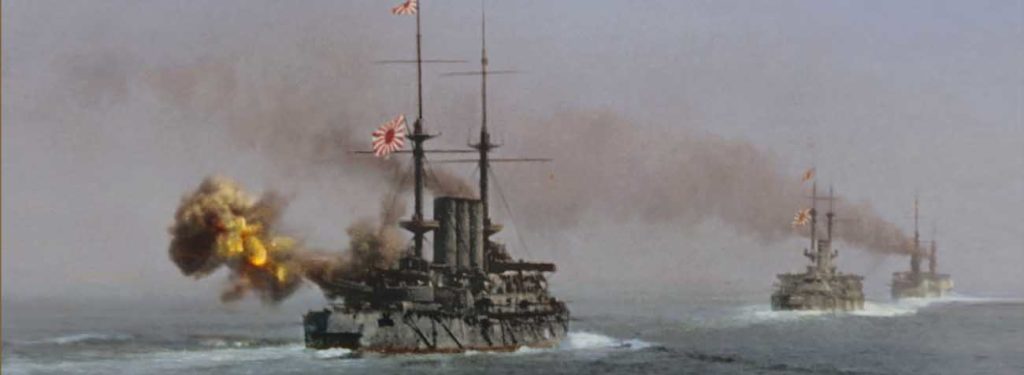
The Japanese battleline, IJN Shikishima in firing exercizes, colorized by irootoko Jr.
—Ironclads—–
-IJN Chin Yen (1882, captured 1894), retired 1914
-IJN Fuji (modernized 1894), retired 1908
—Pre-dreadnoughts—–
-Shikishima class (1898)
-IJN Mikasa (1900)
-IJN Iwami (ex-Orel)
-Sagami class (ex-Peresviet class: Sagami, Suwo, Hizen)
-IJN Tango (ex-Poltava)
-IJN Iki (ex-Nikolai I)
-Kashima class (1905)
-Satsuma class (1906)
—Prewar dreadnoughts—–
-Settsu class (1910)
—Wartime dreadnoughts—–
-Fuso class (1914)
-Ise class (1916)
-Nagato class (1919)
-Kaga class (laid down 1920)
-Kii class (paper projects)
—Semi-Battlecruisers———————
-Ibuki class (1907)
—Battlecruisers———————
-Kongo class (1912)
-Amagi class (laid down 1920)
-N°13 class (paper project)
 Fuji class (1896)
Fuji class (1896)
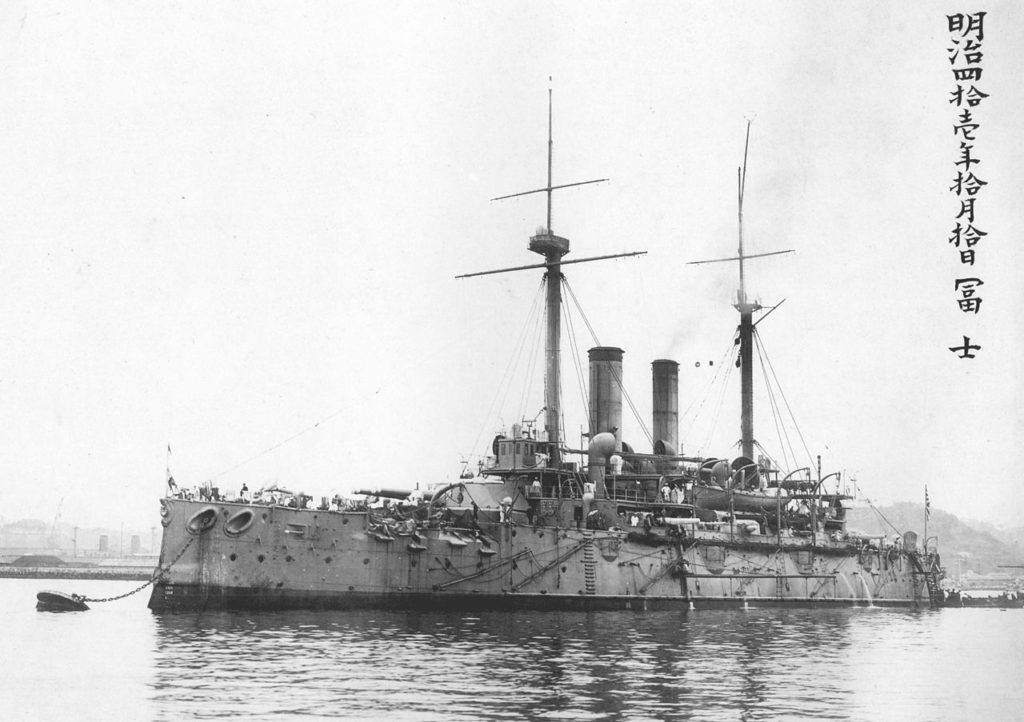
Fuji and Yashima were ordered under the 1893 program to counter the Chinese fleet, notably its two German-built 1880s ironclads. However, they were completed far too late for this war, but were ready as tensions amounted with the Russians. These battleships were designed by G C Macrow, as an improved version of the Royal Sovereign. They had more poerful guns, but of smaller caliber, the classic 12-inches. This choice freed some weight to protect the turret better. Four of the secondary guns were in casemates in the hull, the rest above in open sponsons. Both the Fuji and Yahima differed by their turning circle as shown in trials, Yashima being the most agile of the two.
Indeed, IJN Yashima was built at Armstrong Withworth, Elswick and Fuji at Thames Iron Works, Poplar. Fuji was launched one month later but completed first, in August 1897, her sister ship in September. Yashima experimentally had her keel cut away towards the rudder to save weight, and it was a good find as water moved more freely there. This became rapidly a trademark innovation of the yard and was adopted for subsequent designs.
Both ships had two reciprocal steam engines with vertical tubes (VTE) fed by ten or fourteen (Fuji) cylindrical boilers, single-ended, working at 155 ib/inch2, for a radius of 4000 nm at 10 knots. Both ships were refitted in 1901, the 3-pdr, less those of the fighting tops being deposed, as sixteen 16-pdr were installed instead. This proved a very wise move as shown by the closeer range engagement during the war.
IJN Fuji fired the last shell at Tsushima, sinking Borodino, but IJN Yashima hit a mine at Port Arthur and capsize, before Tsushima. Fuji was re-boilered after the war, her 12-in guns replaced by Japanese models in 1910. She became a coast defence ship. After 1922 she was completely disarmed to respect the Washington’s treaty limitation, used as a training ship. Her propellers were removed, as she was permanently anchored and her tonnage was reduced to 9170 tonnes, draught toon down to 21 feet 9 in, but sh saw WW2 as well, capsizing in 1945, her hulk BU soon after.
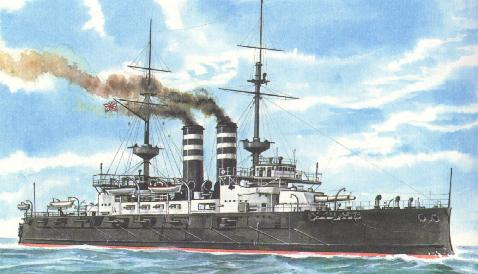
Artists impression of IJN Fuji in 1905
Specifications
Displacement: 14,850 tonnes standard 15,450 FL
Dimensions: 125.5 x 22.4 x 8 m
Propulsion 2 shafts 10/14 cyl. boilers, 14,000 ihp, 1200 tonnes coal, 18 Knots
Armor: Deck 50mm (2-1/2 in), casemate 152mm (2-6 in), belt 457 mm (18 in), barbettes 356 mm (14 in)
Crew: 637
Armament: 4 x 305 (12 in), 10 x 152 (6 in), 20 x 47 mm (3 pdr), 4 x 47 mm (2-1/2 pdr), 5 x 457mm (18 in) TTs sides.
 Shikishima class (1898)
Shikishima class (1898)
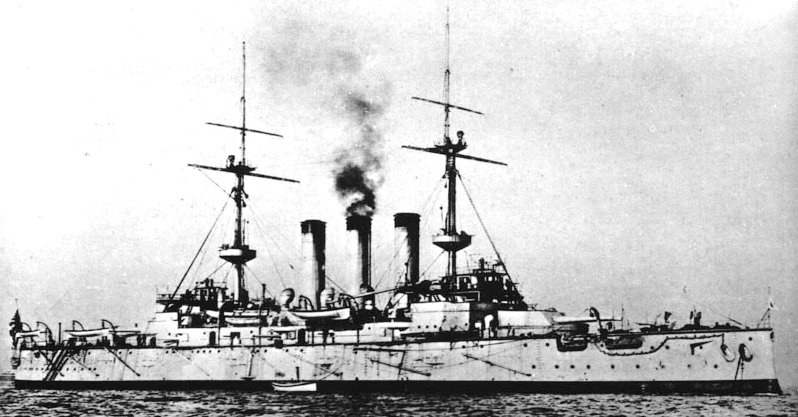
The Shikishima and the Hatsuse were built in two British shipyards on plans derived from the Majestic. They were heavier versions of the previous Fuji and differed in their three chimneys. The later Asahi and Mikasa derive from it so closely that they are sometimes placed within a single class. They were also distinguished by improved armor, comprising no less than 261 watertight compartments. Both ships bombarded Port Athur on February 9, 1904 and actively participated in the blockade that followed. It was in this capacity that the Hatsuse jumped on a Russian mine and could have been saved, being towed by Asahi had it not hit a second mine, exploding in an ammunition store. He sank in seconds with most of his crew. The Shikishima participated in the Battle of the Yellow Sea and in Tsushima. She was in operation during the great war and was decommissioned in 1923. She became a training ship and was not scrapped until 1947.

Author’s illustration of the Shikishima class
Specifications
Displacement: 14,850 T standard – 15,450 tonnes FL
Dimensions: 133.5 x 23 x 8.3 m
Propulsion: 2 shafts, 4 cylinders VTE 14,500 hp 18 Knots.
Armor: Deck 50, Casemate 356, belt 229, barbettes 356
Crew: 836
Armament: 4 x 305, 14 x 152, 20 x 76 mm, 6 x 47, 6 x 45, 5 x 457mm TTs sides.
 IJN Mikasa (1900)
IJN Mikasa (1900)
Mikasa was named after Mount Mikasa in Nara. Her design was a modified version of the Formidable-class battleships, but with two more 6-inch (152 mm) guns. Her main battery consisted of the same four Elswick Ordnance Company 40-calibre twelve-inch guns used in all of the preceding Japanese battleships. These had hydraulically powered mountings with a +13.5° possible loading elevation. She was protected by Krupp cemented armour that had a maximum thickness of 9 inches (229 mm). Laid down at www on 24 January 1899, she was launched on 8 November 1900 and commissioned on 1 March 1902. Like previous ships, there was a four stage artillery, with 12 in, 6 in, 3 in and 2.5/3 pdr guns (47 mm). She also was capable of 18 knots (33 km/h; 21 mph).
She famously was the flagship of Vice Admiral Tōgō Heihachirō during the Russo-Japanese War, in action at the Battles of Port Arthur, Yellow Sea and Tsushima. Just days after war ended, the battleship’s magazine accidentally exploded. As she sank in shallow water, she was salvaged and repaired over two years, but to serve as a coast-defence ship during WWI and the Siberian Intervention in 1920. Two years later, she was decommissioned but preserved as a museum ship at Yokosuka and after years of neglected, refurbishing in the late 1950s; now she is the centerpiece of Mikasa Park in Yokosuka, the last pre-dreadnought in existence worldwide.
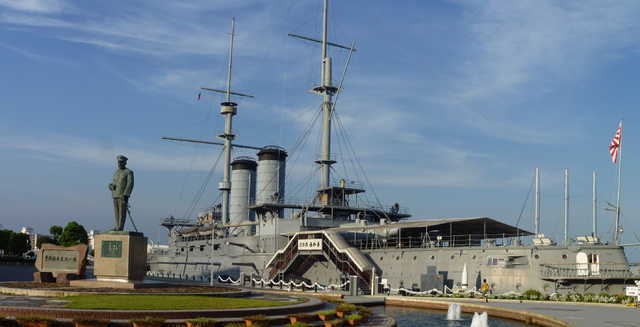
IJN Mikasa at Mikasa Park, Yokosuka. In front, a statue of admiral Togo.
Specifications
Displacement: 15,140 standard – 16,000 tonnes FL
Dimensions: 133.5 x 23 x 8.3 m – 432 x 76 x 27 feet.
Propulsion: 2 shafts VTE, 25 cyl Belleville boilers 15,000 hp. 18 Knots
Armor: Deck 50, casemate 356, belt 229, barbettes 356
Crew: 836
Armament: 4 x 305, 14 x 152, 20 x 76 mm, 6 x 47, 6 x 45, 5 x 457mm TTs sides.
 IJN Asahi (1899)
IJN Asahi (1899)
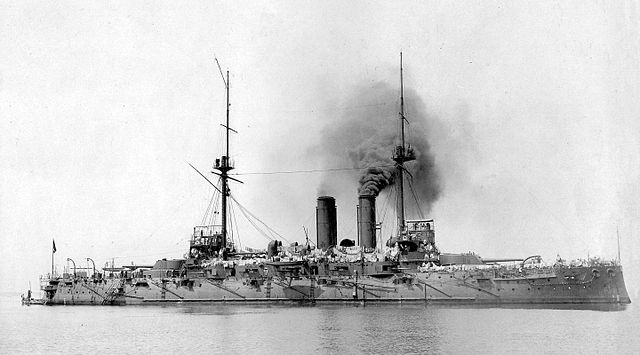
This ship was built at the John Brown shipyards in Great Britain. It was completed in 1900. It was virtually a carbon copy of the Shikishima. Its tests began with problems of profitability of its boilers, consuming excessively coal. this defect was rectified, and it participated in the Russo-Japanese War, hitting a mine on October 26, 1904, it was repaired in time to take part in the Battle of Tsushima, being hit several times. She was demoted to reserve and training in 1914 and was decommissioned in 1923. However, she was converted at Kure to a submarine rescue ship and was put in reserve again in 1938. Reactivated as a workshop ship, she was torpedoed and sunk by the USS Salmon in 1942 off the Indochinese coast.
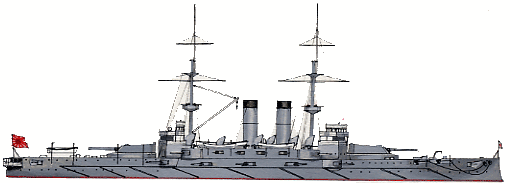
Author’s illustration of the IJN Asahi
Specifications
Displacement: 15,200 tonnes – 15,370 tonnes FL
Dimensions: 129.6 x 23 x 8.3 m
Propulsion: 2 shafts 14 cyl boilers 15,000 ihp 18 Knots.
Armor: Deck 50, casemate 356, belt 229, barbettes 356
Crew: 836
Armament: 4 x 305, 14 x152, 20 x 76 mm, 6 x 47, 6 x 45, 4 x 457mm TTs.
 IJN Tango (1894)
IJN Tango (1894)
Tango was the former Poltava, of the Petropavlovsk-class, battered by field artillery and later captured at Port Arthur after the siege ended. She was refloated by the IJN, comprehensively repaired and modernized, and renamed Tango. During WWI she participated in the siege of Tsingtao but was sold back to Russia in 1916, renamed Chesma passed to the Bolsheviks in October 1917 and was scrapped in 1924. She she served only twelve years under the Japanese flag.
 Sagami class (1903)
Sagami class (1903)
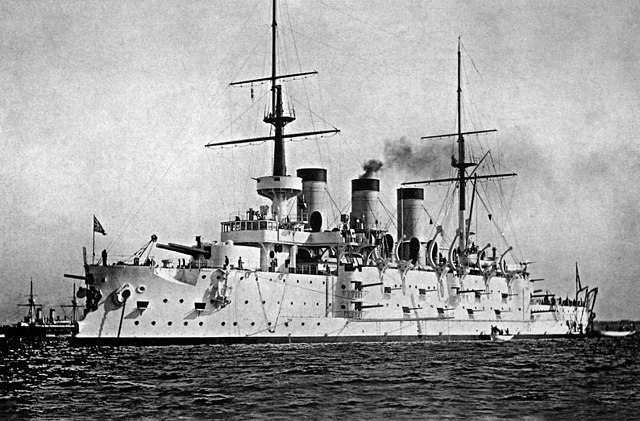
Sagami and Suwo were Peresvet-class battleships, named originally Peresvet and Pobeda, somewhat inspired by the Centurion class, created to defeat the Russian large commerce-raiding armored cruisers and the fast but lightly protected Peresvet class were designed to bring support to the cruisers.
Both were sunk during the Siege of Port Arthur, salvaged by the IJN but after renaming, they were rated as coastal-defense ships. During WWI IJN Suwo was the flagship of the Japanese squadron at Tsingtao, and of the 2nd Fleet. In 1916 she was a gunnery-training ship. She was disarmed in 1922 and scrapped afterward. Sagami was sold to the Russians in 1916, put back into service in Vladivostok under her old name and sent to the Black Sea, then to the Mediterranean. She hit a U73 mine off Port Said in January 1917. Suwo remained in service under the Japanese flag until 1922 when she was broken up.
 IJN Hizen (1903)
IJN Hizen (1903)
Hizen was the ex-Retvizan, built in America before the Russo-Japanese War. She was torpedoed during the Battle of Port Arthur, repaired to be at the Battle of the Yellow Sea, lightly damaged but sunk at Port Arthur by field artillery and later salvaged by the IJN. During WWI she Hizen was sent to reinforce the British squadron off British Columbia and patrolled around Hawaii in search of a German gunboat, intervened in the Russian Civil War in 1919-1920 and was disarmed in 1922, sunk as target. The Irony was she became the first and only US-built battleship.
 IJN Iwami (1902)
IJN Iwami (1902)
Iwami was the former russian Oryol of the Borodino-class. She participated in the Battle of Tsushima, was moderately damaged and surrendered to the IJN. She was completely rebuilt from 1905 until 1907, assigned to the 1st Fleet but reclassified as coast defense ship in 1912. She was at the Siege of Tsingtao in 1914, and became a guardship afterwards, flagship of the 5th Division, 3rd Fleet in 1918. She took part the Japanese intervention in the Russian Civil War. Briefly a training ship she was disarmed in 1922, sunk as target.
 Kashima class (1903)
Kashima class (1903)
The Kashima and Katori built respectively at Armstrong and Vickers, were inspired by King Edward VII. These were the last Japanese battleships built abroad. The Kashima was a bit bigger and heavier than the Katori. Completed in April 1906, they took part only in the great war, their armament being reinforced with two pieces of 78 mm AA. They were both disarmed at Maizuru in 1924.
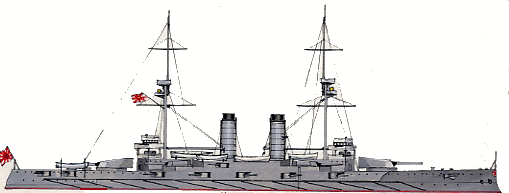
Author’s illustration of the Kashima class
Specifications
Displacement: 16,400 – 17,950 tonnes FL
Dimensions: 144 x 23.80 x 8.1 m
Propulsion: 2 shafts, 20 Niclausse boilers, 15,800 hp. 18.5 Knots
Armor: Deck 50, casemate 228, belt 229, turrets, 229-203, barbettes 152 mm
Crew: 864
Armament: 4 x 305, 4 x 254, 12 x 152, 14 x 78 mm, 5 x 457mm TTs.
 Satsuma class (1906)
Satsuma class (1906)
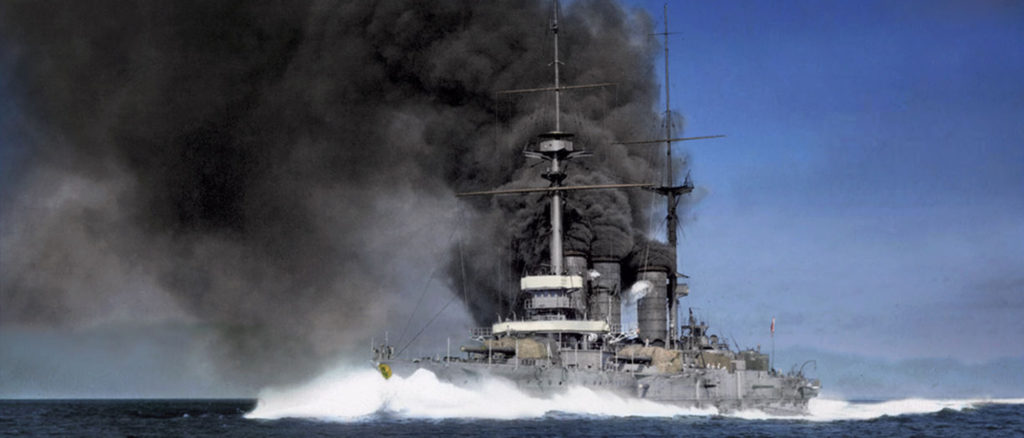
These large battleships are difficult to classify due to the fact that they carry secondary artillery almost as powerful as the main artillery, making them the first Japanese Dradnoughts. Indeed, they certainly carry four pieces of 305 mm but also 12 of 254 mm, logical evolution of the previous Kashima. Like the latter, they diverge somewhat in general terms, except as regards their main artillery: The Satsuma is 146 meters long, 25.4 meters wide and displaces 19,700 tonnes PC – to be compared with the Aki.
One has two fireplaces and the other three. The Satsuma was built in Kure and equipped with 20 Myrabaia boilers, for 17,300 hp and 18.25 knots against 24,000 hp and 20 knots for the Aki, built in Yokosuka. The latter therefore foreshadowed the Settsu to come. These two ships also differed slightly in terms of secondary artillery, the Satsuma having 12 pieces of 120 and 4 of 78 mm. They received two 78 mm AA guns as reinforcements during the conflict. Both served in 14-18 and were decommissioned in 1924, to be used as targets for fire by the battleships Nagato, Hyuga and Mutsu and the battle cruiser Kongo.
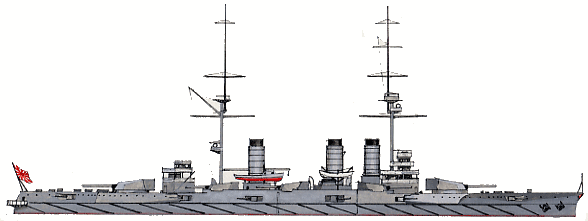
Author’s illustration of the Satsuma class
Specifications
Displacement: 20,100 – 21,800 tonnes FL
Dimensions: 144 x 25.50 x 8.4 m
Propulsion: 2 shafts Curtis turbines, 15 Myrabaia boilers, 20,000 hp. 20 Knots
Armor: Deck 50, blockhouse 228, belt 229, turrets, 229 and 203, barbettes 152
Crew: 864
Armament: 4 x 305, 12 x 254, 8 x 152, 12 x 78 mm, 5 x 457mm sub TTs
IJN dreadnoughts of the Great War (1905)
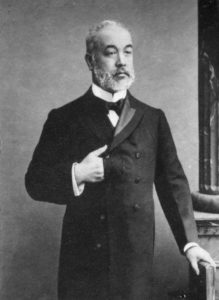 In 1902 was signed the first Anglo-Japanese Alliance, 日英同盟 or Nichi-Ei Dōmei. This very important act only confirmed the already strong relation with British yards and artillery manufacturing. The alliance was already thought after since 1895, during the triple intervention of France, Russia and Germany in the Liandong province. Just one year prior, was signed the 1894 Anglo-Japanese Treaty of Commerce and Navigation. Later it was justified to intensify the country’s modernization as a source of new customers of manufactured goods and machine tooling on the British point of view, as at the same time helping putting down the Boxer rebellion. The press also advocated for such alliance, like the Times and The Telegraph. In Japan the cause was pushed ahead by Ōkuma Shigenobu, also relayed by newspapers.
In 1902 was signed the first Anglo-Japanese Alliance, 日英同盟 or Nichi-Ei Dōmei. This very important act only confirmed the already strong relation with British yards and artillery manufacturing. The alliance was already thought after since 1895, during the triple intervention of France, Russia and Germany in the Liandong province. Just one year prior, was signed the 1894 Anglo-Japanese Treaty of Commerce and Navigation. Later it was justified to intensify the country’s modernization as a source of new customers of manufactured goods and machine tooling on the British point of view, as at the same time helping putting down the Boxer rebellion. The press also advocated for such alliance, like the Times and The Telegraph. In Japan the cause was pushed ahead by Ōkuma Shigenobu, also relayed by newspapers.
Before the war of 1905, relations with the Russian Empire, expansionist in the east, started to threaten British presence and relations became tense. Japan was seen as a proxy of the Empire to check the Russian’s ambitions in the area. In the end, going above resistance on the matter, Tadasu Hayashi, for Japan, and Lord Lansdowne for the British Empire, started discussions in 1901 over disputes with Korea but pushed reconciliation with Russia, and ultimately discussions were relaunched at the end of the year, it was signed in a hurry, as a peace-time military alliance, between equal partners, a first between west and east.
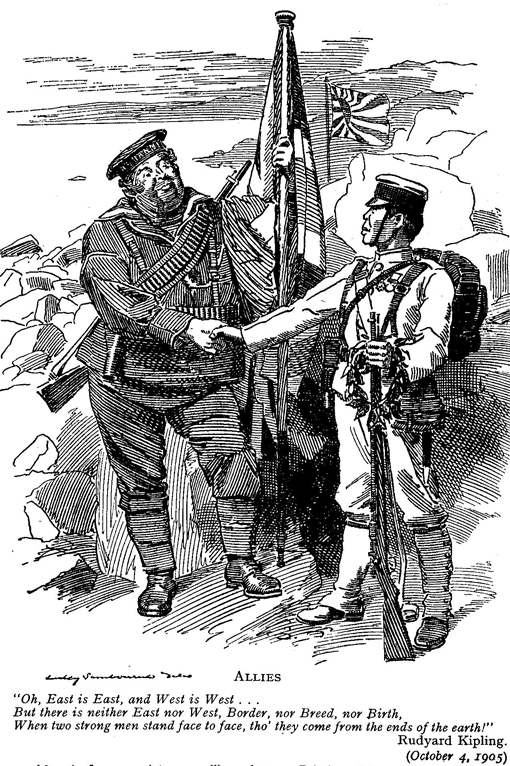
Punch caricature of the treaty
One of the consequences was of course stronger bonds with the Royal Navy. The IJN became the “most anglophile navy on earth” from ships to armament, to academy, doctrine and tactics. The treaty was renewed and extended in 1905 and 1911. In 1905, this perhaps gave Japan access to the knowledge of the construction of HMS dreadnought, ar at least a glimpse of it (it is still debated). Indeed, because of a sever economical depression, the Kawachi-class, first Japanese dreadnoughts, were only ordered in june 1907, as part of the 1907 Warship Supplement Program, and by that time, only Germany was early in this, laying down the keel of her first Nassau class in July 1907, which design was modified by the release of the Nelson class (1905), last pre-dreadnought and considered as “semi-dreadnoughts”. Nevertheless, the Settsu and Kawachi, commissioned in 1912, were still a bit transitional in nature with their early artillery configuration, 12-in turrets on the broadside. The next Kongo class (1913) were already much more modern with their axial artillery and 15-in guns (see later).
 Kawachi class (1910)
Kawachi class (1910)
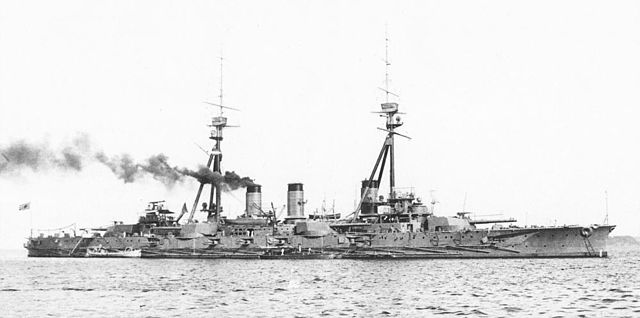
The first real Japanese monocaliber, or dreadnought-type battleships, the Settsu and kawachi, were launched in 1910 and 1911 and completed in 1912. Much heavier and this time equipped with powerful turbines, built under license by Kawasaki. They were armed with 12 pieces of 305 in double turrets (four lateral, one front and one rear), and pieces of different range: The two front and rear were caliber 50 and 45 for the others. These two ships differed only slightly in their displacement (21,443 tonnes for the Settsu and 20,823 for the Kawachi.). They could reach 20 knots and participated in the great war, but the kawachi was lost in 1918 following a catastrophic accidental explosion of an ammunition storage in Tokuyama Bay. IJN Settsu was decommissioned in 1922 and used as a radio controlled target for light bombing. She was modified several times, losing her armour in part, boilers, and had a very different appearance in 1941. She was sunk by American aviation in July 1945.

Wow’s rendition of the Kawachi class
Specifications
Displacement: 21,400 – 22,900 tonnes FL
Dimensions: 160 x 25.70 x 8.5 m
Propulsion: 2 shafts Curtis turbines, 16 Myrabaia boilers, 25,000 hp. 20 Knots
Armor: Deck 50, blockhouse 228, belt 229, turrets, 229 and 203, barbettes 152
Crew: 864
Armament: 12 x 305, 10 x 152, 8 x 120, 12 x 78 mm, 5 x 457mm sub TTs.
 Fuso class dreadnoughts (1914)
Fuso class dreadnoughts (1914)
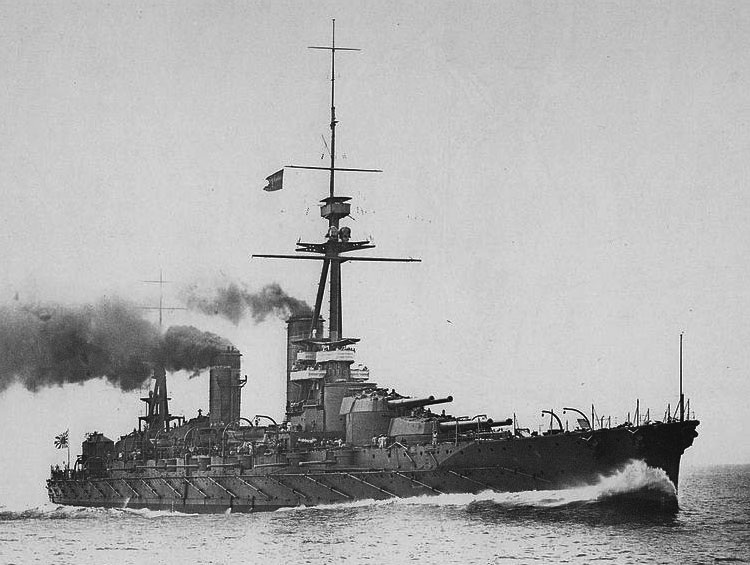
IJN Fuso in 1915
The Fuso and Yamashiro, launched in 1914 and 1915 and completed in 1915 and 1917 became be the first Japanese ‘super-dreadnoughts’ with axial artillery, responding to the Kongo-class battle cruisers released earlier. By their dimensions, their speed and their firepower, they marked a new milestone in the escalation of resources the fleet was giving itself. These ships will have a long active career, and underwent two overhauls, a first in 1923, which saw them equipped with a pagoda-like bridge around the tripod mast and funnel covers. IJN Yamashiro tested a small flying-off platform installed on one of the turrets, and the operating three in 1925; their second overhaul saw them equipped with new machinery, a tower bridge, a powerful AA artillery among others. But this concerns the Fuso record in 1941.
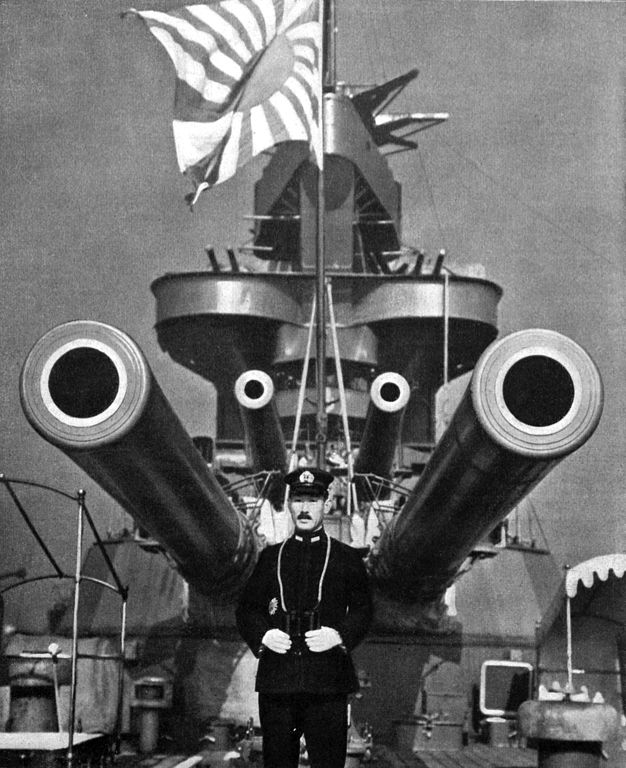
IJN Yamashiro and Vice admiral Sankichi Takahashi

Author’s illustration of the ise class
Specifications WWI
Displacement: 30,600 tonnes standard, 35,900t FL
Dimensions: 202.70 x 28.70 x 8.7 m ()
Propulsion: 4 shafts Brown-Curtis turbines, 24 Miyabara boilers, 40,000 hp. 22.5 Knots.
Armor: Deck 76, blockhouse 305, belt 305, turrets, 305 and 204, barbettes 152
Crew: 1193
Armament: 12 x 356, 16 x 152, 4 x 78 mm AA, 6 x 533 mm TT sub
 Ise class dreadnoughts (1916)
Ise class dreadnoughts (1916)

IJN Ise colorized by Irootoko Jr
The Ise and the Hyuga, launched in 1916 and 1917 and completed in 1917 and 1918 follow the Fuso in many points, but manage to combine the presence of an additional turret with a slightly extended hull (three meters). An additional space which benefits the machines, allowing a power gain of 5000 hp and a speed of 23 against 22.5 knots. In terms of armament, the choice is made to multiply the number of pieces of a lower caliber (140 mm against 152), modern and better suited to the loader gunner’s size. In 1926-27 a slight overhaul saw them adopt a front chimney deflector hood while they saw their front masts being covered with gangways. They also carried three seaplanes launched from a platform installed on the roof of the fifth turret. Their second overhaul of 1934-36 saw them equipped with new machines, a reconstructed tower bridge, a substantial increase in their 356mm guns, AA artillery, and catapults. Their last overhaul will transform them in 1942-43 into aircraft carrier hybrids.
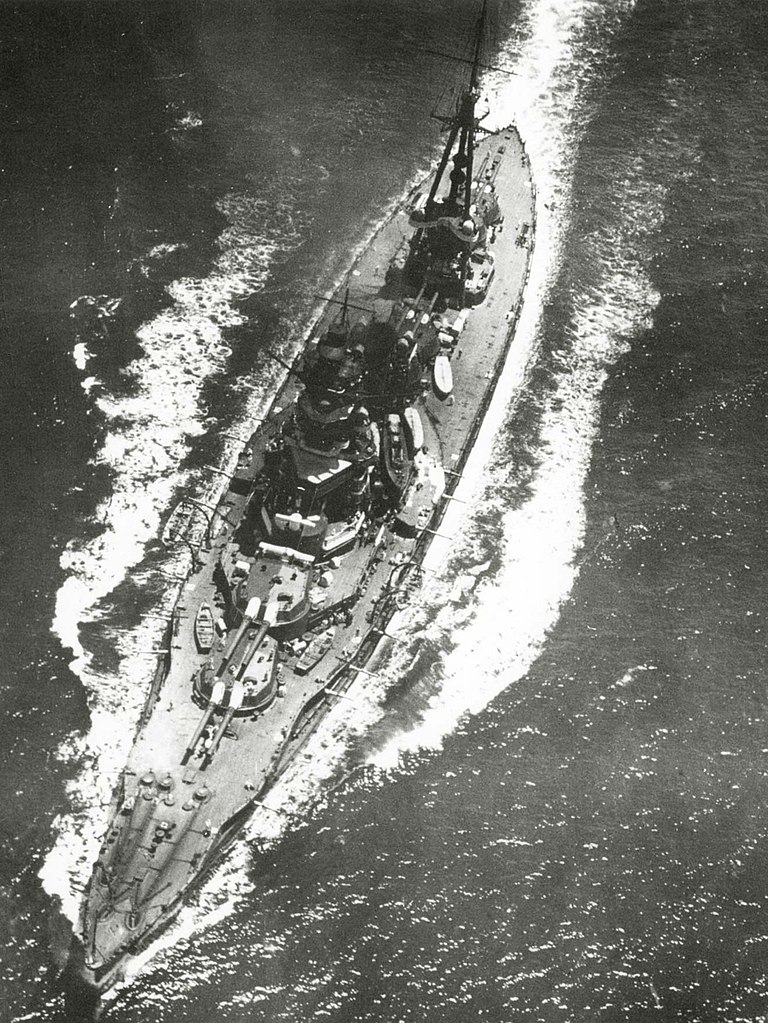
IJN Hyuga in 1927

Author’s illustration of the ise class
Specifications (WWI)
Displacement: 31,260 – 36,500 tonnes
Dimensions: 205.80 x 28.70 x 8.8 m
Propulsion: 4 shafts Curtis or Parsons turbines, 24 Kampon boilers, 45,000 hp. 23 Knots.
Armor: Deck 76, blockhouse 305, belt 305, turrets, 305 and 204, barbettes 152; Crew 1360
Armament: 16 guns of 356, 20 of 140, 4 of 78 mm AA, 6 TLT 533 mm SM.
 Nagato class (1919)
Nagato class (1919)
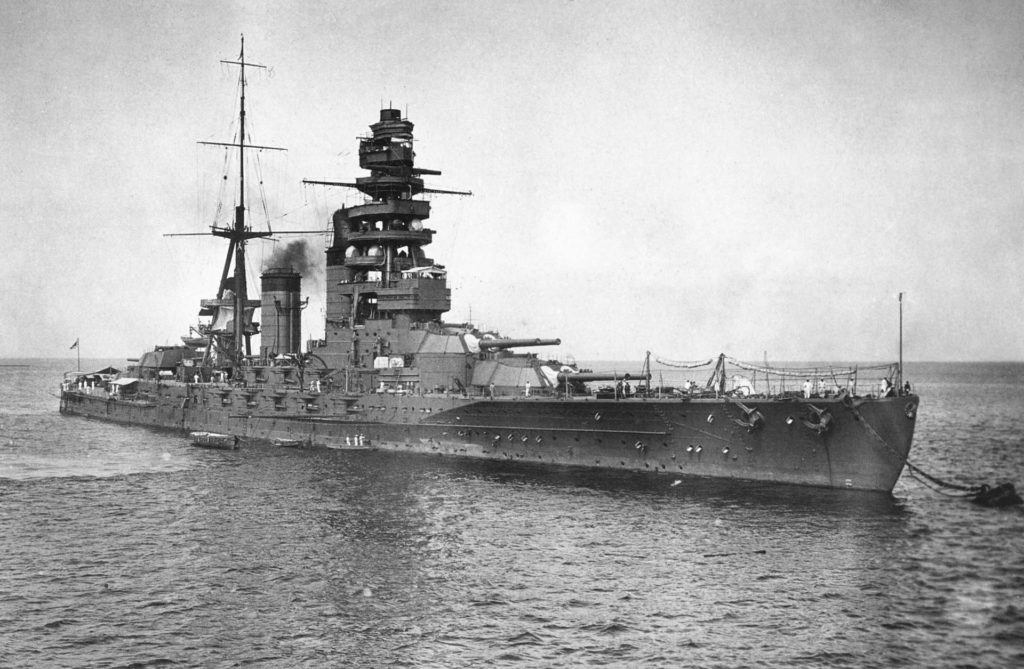
The last Japanese battleships actually in serive before 1941, the Nagato were the culmination of progressive improvements which were reflected in the armament, for the first time a battery entirely composed of parts of 410 mm, superior to the last American dreadnoughts (406mm) and more British Queen Elisabeth and Resolution (381mm). In addition to these aspects, the Nagato and Mutsu, her sister ship, had an all-heptapotdale pagoda (seven feet) in and around which rested numerous bridges, observation and telemetry decks. Also innovative, the design of the stern with a rounded “icebreaker” type setback, and a powerful secondary artillery barbettes divided into two battery decks. The armor had also been revised, and the two ships had a total weight as standard of 32,700 tons, for a machine power of 80,000 hp, guaranteeing a top speed of 26 knots (48 km / h). Compromises had been found, in the armor which did not exceed 369 mm for the front blockhouse and 305 mm elsewhere. Without being true battle cruisers, the Nagato were a compromise between the two classes. Nagato and Mutsu will be in service in November 1920 and October 1921, early enough to escape the Washington moratory. They will be completely rebuilt in 1933-36 and gained a new AA artillery, then for the Nagato in 1944 radars and other equipment, with a standard weight of 39,130 t.

Author’s illustration of the Nagato class as modernized in WW2 (1919 illustration in preparation)
Specifications
Displacement & Dimensions 23,700 – 27,900t; 215.8 x 29 x 9 m
Propulsion 4 propellers, 4 reduction turbines, 21 Myrabaia boilers, 80,000 hp. and 26 Knots max.
Armor, crew Deck 144, blockhouse 369, belt 305, turrets 305, barbettes 305
Crew 864
Armament 8 guns of 410, 20 of 140, 4 of 76 mm, 8 TLT 533 mm SM.
 Tosa class (1920)
Tosa class (1920)
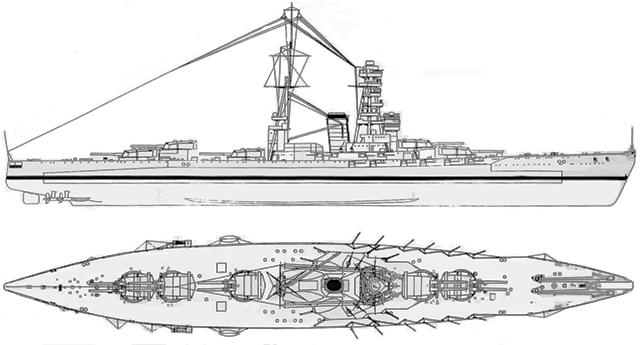
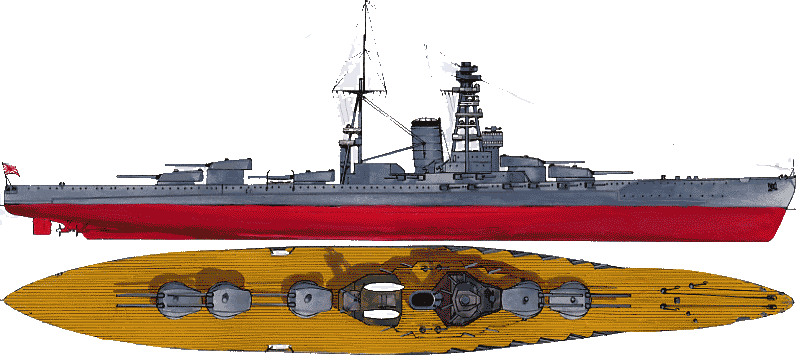
The projected Tosa in 1920 (author’s rendition)
The Tosa-class battleships were dreadnoughts ordered as part of the “Eight-Eight” fleet in 1920 of the IJN. They were basically designed as larger versions of Nagato class, with the same 16.1 in (410 mm) twin turret, but one more as previously planned for the Nagato initially, and this design was retaken for the Amagi-class battlecruisers.
For the context, the IJN believed a configuration with eight battleships and eight armoured cruisers was the best fleet combination. The plan was ratified in 1907 and became the Eight-Eight Fleet Program, later transformed into sixteen capital ships, less than eight years old, hence the name. This was quite ambitious an was half-realized before the Washington treaty, with the two Fuso, two Ise and four Kongo. Both the arrival of the HMS Dreadnought and HMS Invincible and the plan was modified in 1911, but it was rejected by the Diet. FY1916 saw only the Nagato and two battlecruisers authorized, changed when President Wilson US plans for ten additional battleships plus six battlecruisers: A second Nagato-class battleship and tw modified modified design, Tosa and Kaga.
The Nagato design was already reevaluated following lessons from the Battle of Jutland in 1916, notably round armor protection, based on knowledge on protective schemes in USN and Royal Navy capital ships. The main gun turrets and magazines had all attention, plunging to deflect plunging fire, a better deck armor, while ASW hull defense against mines and torpedoes were also revised. Eleven designs were rejected until 1917 and Captain Yuzuru Hiraga presented a completely new version of the Nagato design called A-125. IJN Mutsu was to be rebuilt using this on 12 June 1917 before laid down, but eventually the design was rejected as delaying too much the class completion as a whole by the Navy Ministry.
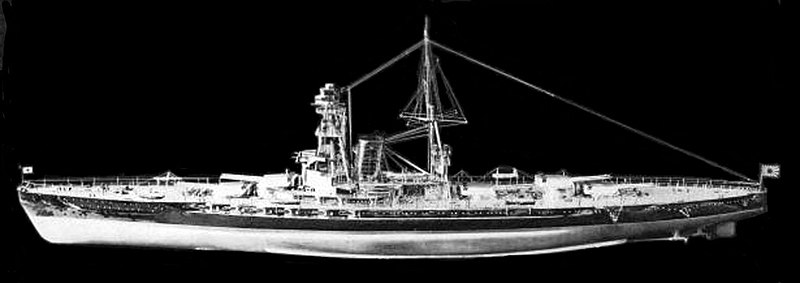
Model of the Akagi
Hiraga’s A-125 design incorporated also better boilers and one twin main-gun turret was added thanks to the space freed by the new, lighter and more compact twelve new boilers without loss of power or speed. The secondary armament was down to 16 guns but moved one deck higher to ensure perfect arc of fire and viability in heavy weather. Another design feature was the belt anled outwards instead of the usual practice. For pluging fire, it proved buch better effience, and was still quite resistance to horizontal fire. The lower deck armor and Torpedo bulkhead were also thickened while anti-torpedo bulges were integrated. The plans were modified to a 39,000 ton battleship named A-127, with all armor figures raised for in final having twice as much armor as the Nagatos, and keeping the same speed, and this was accepted on 27 March 1918.
The (future) Tosa-class, still unnamed was to displace fuly laden as much as 44,200 tons and up to 234.09 meters (768 ft) overall and a draught of nearly ten meters. It was to be equipped (US influence there) by brand new turbo-electric systems, for an estimated figure of 70,000-shaft-horsepower, procuring 25.25 knots. Later this system seemed too far-fetch and rejected in favor of a more conventional system with Curtis geared steam turbines and 12 mixed burning Kampon water-tube boilers, for 91,000 shp and four propeller shafts, and one knot more at 26.5 knots. No change for the main artillery, but a return to twenty secondary guns.
Construction started for IJN Tosa on 16 February 1920 at the Mitsubishi Shipyard, Nagasaki, she was launched on 18 December 1921 and was planned for completion on March 1923, as contracted while IJN Kaga was laid down at Kawasaki Shipyard, Kobe, launched on 17 November 1921 and planned for completion on 25 December 1922.
Both were launched in late 1921 but cancelled according to the Washington Treaty before completion. Tosa was used in to test the latest of armour scheme, pounded by several battleships until she was scuttled in the Bungo Channel as an artificial reef. The hull her sister ship Kaga, was later converted into an aircraft carrier according to lenient conditions in the treaty in what was seen as a fleet auxiliary. The completion of Kaga as an aircraft carrier as soon as authorized, on 13 December 1923, but the great Kanto earthquake damaged the Yokosuka Naval Arsenal and work lasted from 1925 to 1928 when she was commissioned, starting her sea trials and joining the Combined Fleet or Rengō Kantai on 30 November 1929, actually after the Akagi. The rest is history, as she was sunk in 1942 at Midway.
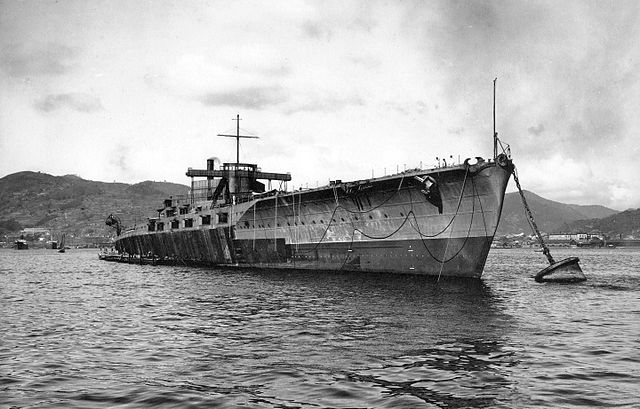
The Tosa after launch, pending completion, on 31 July 1922, still no superstructure but a small bridge to oversea the tugging.
 Kii class (projects)
Kii class (projects)

Rendition of the Kii
The Kii class were more than paper project as construction was ordered and started. For the first time, four “fast battleships” were planned for the Imperial Japanese Navy (IJN) and only the first two received names. They were part of the “eight-eight fleet” approved by the diet, following announced the USN major construction of 1919, but curtailed by the Washington Naval Treaty three years later, and consequently all work was suspended and cancellation followed in November 1923 and April 1924. If delivered, these would have be the largest and fastest battleships* in Asia, but not on earth, but not armed with the new 18-in standard caliber planned by other navies.
*The USN Lexington class battlecruisers displaced on paper 45,500 tonnes FL, the South Dakota class (48,000), but the Kii class were less impressive than the British G3 battlecruisers (53-54,000 tonnes FL), or N3 Battleships (around 55,000).
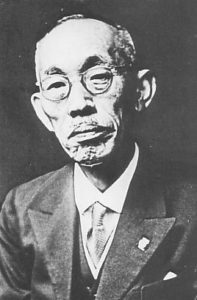 Crucially these ships were designed by Captain Yuzuru Hiraga and largely repeats of the preceding Amagi-class battlecruisers derived from the Tosa-class in turn, and were basically stretched to use more powerful machinery in order to add extra armour. Still, the Amagi class were faster, and since the Kii were an in-between they were called “fast battleships” ending distinction between “battleship” and “battlecruiser” the Japanese thought superfluitous. In that, they were right as more navies will do the same after the treaty ban was lifted.
Crucially these ships were designed by Captain Yuzuru Hiraga and largely repeats of the preceding Amagi-class battlecruisers derived from the Tosa-class in turn, and were basically stretched to use more powerful machinery in order to add extra armour. Still, the Amagi class were faster, and since the Kii were an in-between they were called “fast battleships” ending distinction between “battleship” and “battlecruiser” the Japanese thought superfluitous. In that, they were right as more navies will do the same after the treaty ban was lifted.
They were quite large already at 250.1 meters (820 ft 6 in) overall for 30.8 meters (101 ft 1 in) wide and 9.7 meters (31 ft 10 in) draught, but their normal displacement was 42,600 metric tons. They were at the original to be propelled by four of the new projected high-power Gijutsu-Hombu geared steam turbines, one for each propeller shaft. Fed by 19 Kampon oil-fired water-tube boilers, their total ouptut was planned to be in the order of of 131,200 shaft horsepower (97,800 kW), enough to reach 29.75 knots (55.10 km/h; 34.24 mph) which was indeed a fraction of a knot less than the Amagi. Like the Amagi and Tosa they were armed with ten 41 mm/45 (16.1 in) guns, with three aft of the superstructure including one on the battery deck at the same level as the number four superfiring turret. The secondary battery was a step-up in caliber, to the price of four guns less: Sixteen 140 mm/50 (5.5 in) guns in the hull, and not in the superstructure. The ships were still also armed by torpedo-tubes, eight of the heavy 610 mm (24 in) torpedo tubes, all above water. More importantly were their protection figures, with waterline belt 292 mm (11.5 in) thick and sloped 15° outwards, designed to defeat 16-inch (410 mm) shells up to 20,000 m. Turrets faces and and barbettes reached 280 mm (9.0–11.0 in) and 356 mm (14 in) for the CT, 120 mm for the armoured deck.
Both the Kii and Owari were ordered on 12 October 1921, plus two more in December. Kii was to be built respectively at Kure Naval Arsenal, (completion planned for November 1923) and Owari at Yokosuka Naval Arsenal (September 1923) while Numbers 11 and 12, were respectively given to Kawasaki (Kobe) and Mitsubishi (Nagasaki), with completion dates around 1925. The keel laying was just started, when it was stopped on 5 February as the Washington Naval Treaty was signed, notably forbidding to go further than 35,000 long tons (36,000 t) in standard displacement.
Specifications
Displacement: 42,500 – 48,800t FL
Dimensions: 250 x 30 x 9.8 m
Propulsion: 4 shafts geared turbines, 19 Kampon boilers, 131,200 hp. and 29.75 Knots max.
Armor: Deck 120, CT 356, belt 292, turrets 280, barbettes 280
Crew: 1200
Armament 10 x 410, 16 x 140, 4 x 76 mm AA, 8 TLT 610 mm SM.
 N°13 class battleships (project)
N°13 class battleships (project)

Rendition of project 13 class. This would have been the largest capital ship in the world if completed (around 1925).
The Number 13-class battleship was a planned deveooment of the Kii, and like the latter, four “fast battleships” only planned when the Washington treaty was signed. They were ordered but soon cancelled as a conquence and never received proper names. They are known as N°13–16, to be built at the NyDs of Yokosuka, Kure, Mitsubishi and Kawasaki. They were part of the 1920 finally approved “eight-eight fleet” and these ships were to be superior to any other battleships of the time, they were in effect, the Yamatos of their day.
The plan requiring the construction of eight new fast battleships to replace the Kongo, Fuso and Ise in one go were to be the Kii and the Number 13 classes. The latter were designed by Hiraga,
and acted on a Japanese doctrine followed since the First Sino-Japanese War, of compensating for the quantitative by the qualitative, still valid in 1941. Because of their nature of fast battleship and heay armour, while combined with the new 18-in guns, they would have in effect outclassed any capital ship in existence if completed as planned around 1926-27. They derived in a long line of designs going back to the Nagato, through the Tosa, Amagi and Kii. The great novelty was to stretch out the kii design to absorb brand new guns of the official caliber of 457 mm (18 in) guns. For this, the hull was lenghtened to 274.4 meters (900 ft 3 in) overall, so almost ten meters more than the 1941 Yamato, which however were almost twice more heavily armoured and much heavier in displacement.
Normal displacement noted was 47,500 metric tons (46,700 long tons) which gives an estimated 59,000 to 62,000 tonnes fully laden. Both by displacement and speed, this would have made them superior to the British N3 class, and even the “battlecruisers” of the G3 class. No doubt also that the new 457 mm guns were in reality of a larger caliber, with a longer barrel for extra range. However, this made for only four twin turrets in the latter case, against three triple. The N°13 class were propelled by the same four Gijutsu-Hombu geared steam turbines but mated to more Kampon boilers (22) in order to reach 150,000 shaft horsepower and a top speed equal to the Amagi class, 30 knots. Speed at the time was a crucial factor as it allowed to outmaneouvered the enemy and “crossing his T”, with devastating results.
The 18-in guns was never built, but it would have fired a 1,550-kilogram (3,420 lb) shell at 800 meters per second at a 35,000+ m range, and the secondary battlery of 140 mm (5.5 in) was moved to the superstructure like the previous Kii, while AA would be from four to eight 120 mm (4.7 in) DP guns around the funnel, plus the same eight above surface 24 in torpedo tubes. Armour figures were quite impressive, made to defeat similar caliber of 18-in: 330 millimeters (13 in) angled at 15° outwards for the waterline, and a deck armor 127 mm (5 in) thick.
Specifications
Displacement: 47,500 t standard – 58,000? t FL
Dimensions: 274.4 x 30.8 x 9.8 m
Propulsion: 4 shafts geared turbines, 22 Kampon boilers, 150,000 shp, 30 Knots max.
Armor: Deck 127, CT 356, belt 330, turrets 330, barbettes 330
Crew: 1200
Armament 8 x 457, 16 x 140, 8 x 120 mm AA, 8 TLT 610 mm aw.
IJN semi-battlecruisers and battlecruisers of the Great War (1905-1920)
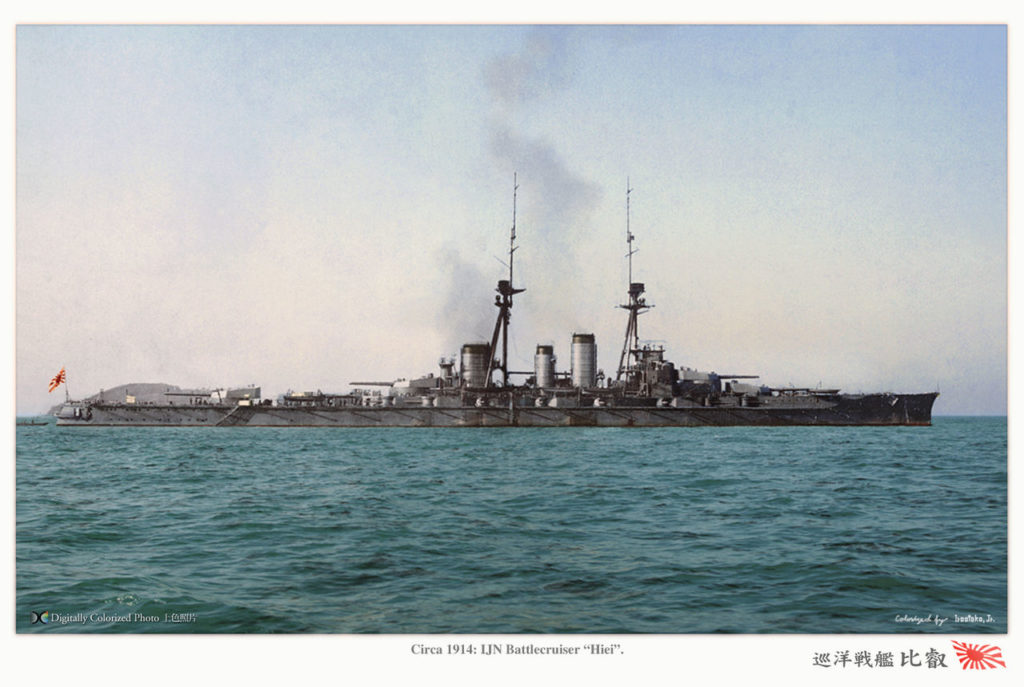
Japan had a gradual approach to the matter. Although most historians points out the first Japanese battlecruiser per se was the Kongo class in 1913, Japan built two classes of expecptionally well armed armoured cruisers, which in the light of contemporary designs, could be assimilated to “semi-battlecruisers”. They had in common an exceptionally heavy armament of 12-inches main gun as most foreign designs were armed wit 10 inches at best, a formidable secondary battery and a protection to match anything that was an armoured cruiser at the time. They were intended as authentic “fleet cruiser”, designed to take place in a battleline of battleships, with a better speed in order to perform the famous “crossing the T” tactic after the Russo-Japanese war. The Tsukuba class on that matter, were completely redesigned. However, the first true battlecruisers were ordered in 1911 in the UK, with two more built in Japan: This was the Kongo class.
At the time, news that four heavily armed battlecruisers based on the Britsh Lion class caused a sensation. Some speculated they were even to be resold to the Germans shortly and asked to suspend the sell. But it made sense through the recently reinforced alliance treaty between UK and Japan. These four ships brought out an amazing weight to the Japanese fleet just as the war broke out. They were comprehensivelt modernized twice during the interwar, with an icreased protection which made them fast battleships, and no longer battelecruisers. Brand new powerplant more than made up for the increased weight of the additional protection.
More were planned, with pioneering concepts such as very well protected battlecruisers which were in fact, fast battleships in disguise. With 18 inches guns, 30 knots and 50,000 tonnes they were amazing ships indeed, but would have probably bled the Japanese budget white.
 Tsukuba class semi-battlecruisers (1905)
Tsukuba class semi-battlecruisers (1905)
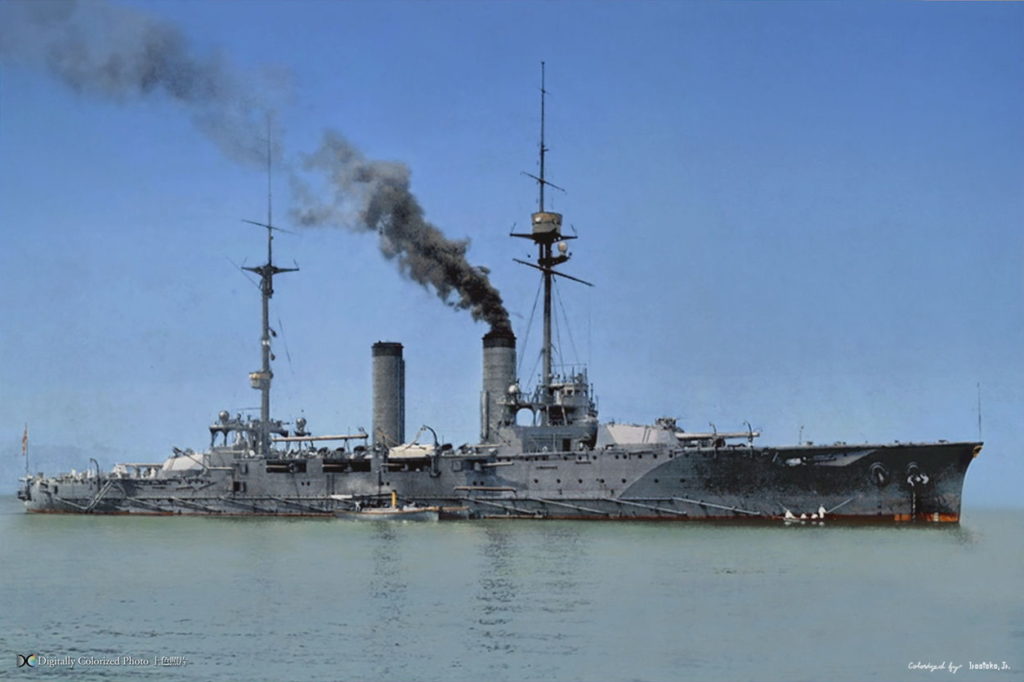
IJN Tuskuba, colorized by Irorotoko Jr
The Tsukuba and the Ikoma, two battleship cruisers armed with 305 mm guns were the result of a request from the navy after the observation of long-range fire from the Russians during the Battle of the Yellow Sea, and in replacement of the Hatsuse and Yashima, having blown up mines in Port Arthur. At their completion, after a rapid construction (too much, given the defects noted later), they were too slow and above all too weakly armed to be compared to real Battlecruiser equivalents, but were all the same classified as such by the General Staff. During the great war, on January 14, 1917, IJN Tsukuba suffered a violent accidental explosion of one of its ammunition bunkers which tore its sides, killing 305 victims. She sank on the shallows of Yokosuka Bay and was later refloated and demolished. IJN Ikoma became in 1919 a training ship for gunners, being rearmed with 10 pieces of 152, 8 of 120 and 6 of 45 mm. She was struck off the lists in 1924, after only 16 years of active life.
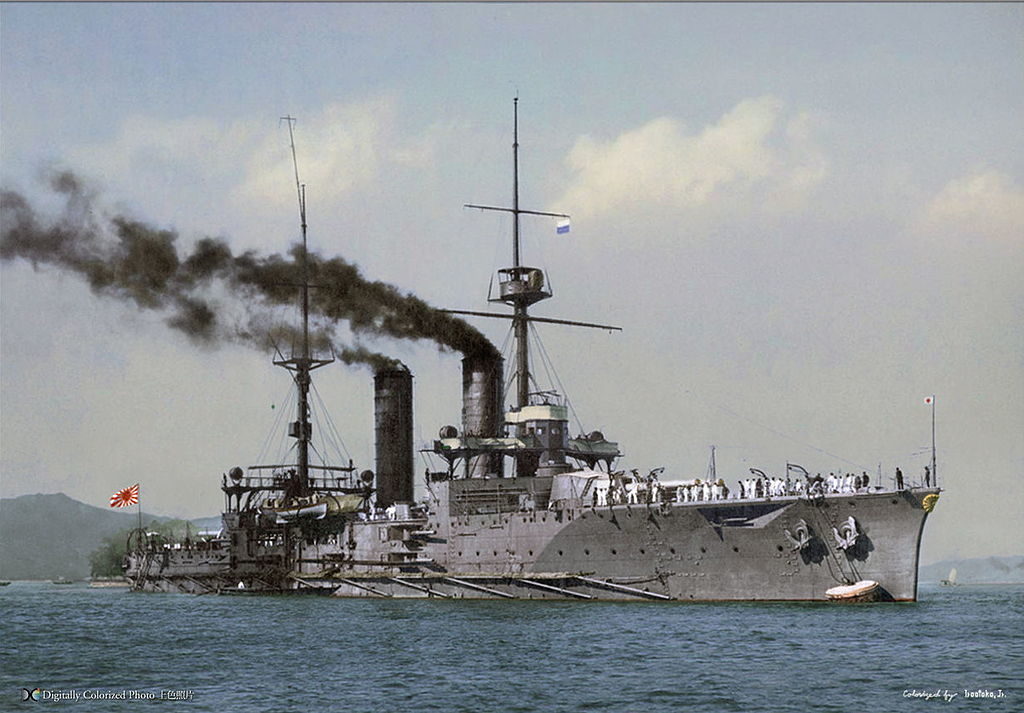
IJN Ikoma, colorized
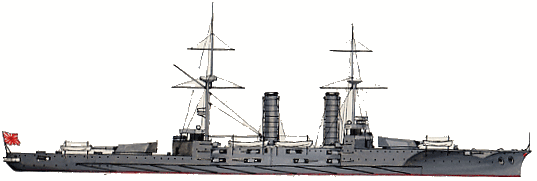
Author’s illustration of the IJN Tuskuba class
Specifications
Displacement: 15,400t FL
Dimensions: 137.2 x 23 x 8 m
Propulsion: 2 shafts VTE, 20 Miyabara boilers, 20,500 hp. 20.5 knots max.
Armor: 203 mm
Crew: 844
Armament: 4 x 305 (12 in), 12 x 152 (6 in), 12 x 120 (5 in), 4 x 45 mm (2 in), 2 x 40 mm AA, 3 x 457mm (18 in) TTs.
 Ibuki class semi-battlecruisers (1907)
Ibuki class semi-battlecruisers (1907)
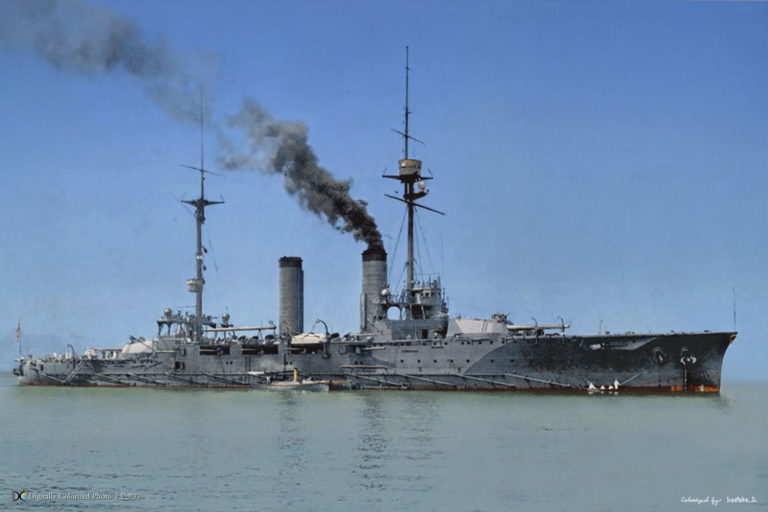
IJN Kurama in Kure, 1914, colorized by irooToko Jr.
The IJN Ibuki and Kurama, built in Kure and Yokosuka respectively, were derived from previous Tsukuba. They did not differ in size but in their turbines, a first for Japanese ships, and their armament reinforced with 203 mm pieces. In addition, the two units differed between them, Ibuki having lower funnels and single masts, but also turbines bringing its power to 24,000 hp against 22,500 and 21.5 knots against 20 on the Kurama equipped with machines. standard. Both served during the Great War, the Ibuki participating in the hunt for Von Spee before sending concois Anzac (Australian troops) to the Dardanelles front via Suez. They were disarmed in 1924-25 and struck off the lists (Full article to come).
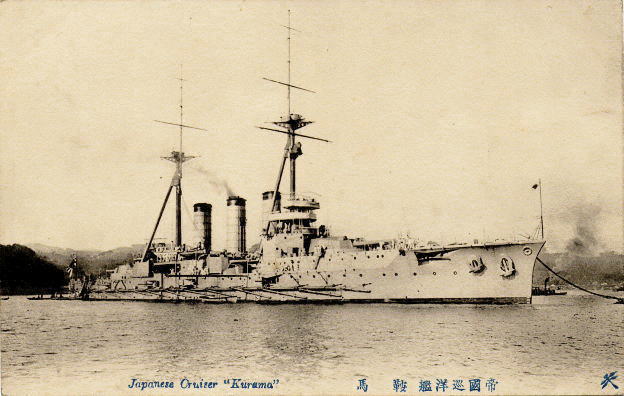
Old postcard showing the IJN Kurama
Specifications
Displacement: 15,595t FL
Dimensions: 137.2 x 23 x 8 m
Propulsion: 2 shafts VTE, 20 Miyabara boilers, 22,500 hp. 20.5 knots.
Armor: 203 mm
Crew: 844
Armament: 4 x 305 (12 in), 8 x 203 (8 in), 14 x 120 (5 in), 4 x 45 mm (2 in), 3 x 457mm (18 in) TTs
 Kongo class battlecruisers (1912)
Kongo class battlecruisers (1912)
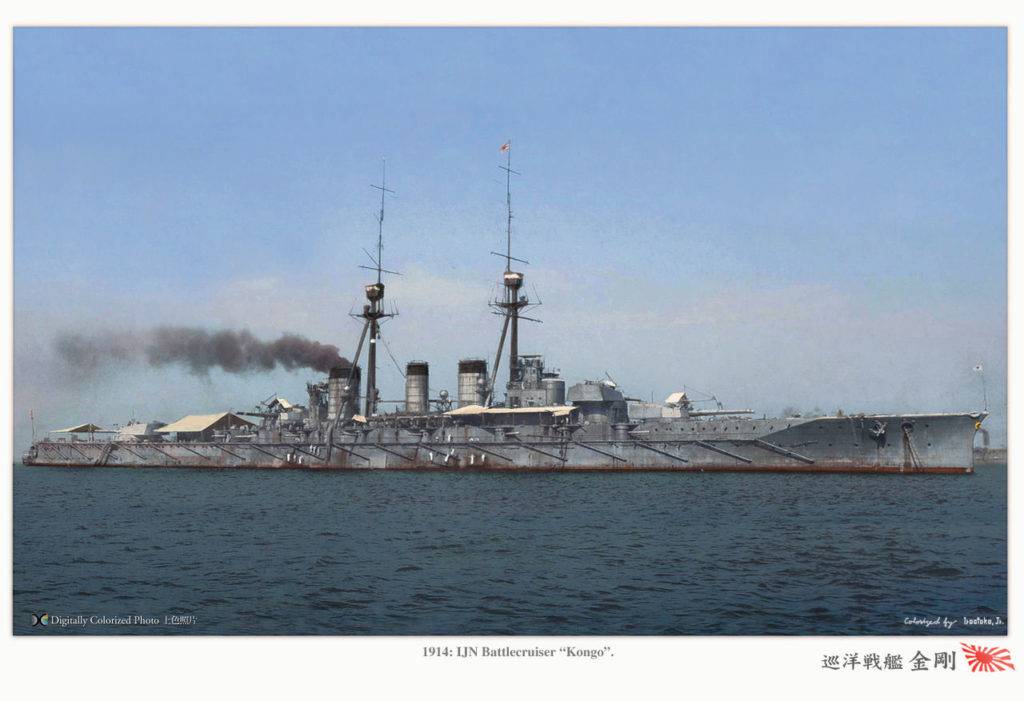
IJN kongo – Colorized by Irootoko Jr
The Kongo, Haruna, Hiei and Kirishima were four formidable vessels commissioned from Great Britain in 1910, launched in 1912 and 1913 and completed just before the start of the great war. Designed a bit on the model of the Tiger, they showed that the Japanese admiralty had decided to move to a higher pace, and that it was clearly confirming its dominant place in Asia. The British certainly did not expect to find them one day in front of them. They served amply in the Pacific, demonstrating their relevance by being very effective in the role of “beaters” from the German Pacific Fleet (Graf Von Spee) to the British squadron in 1914. The front was calm, and their career was unsuccessful. stories, from assignments to assignments. In 1919, they would undergo a short overhaul and modernization, but the main one came in 1927-29, at the end of which they became fast battleships, the first of the Japanese navy.
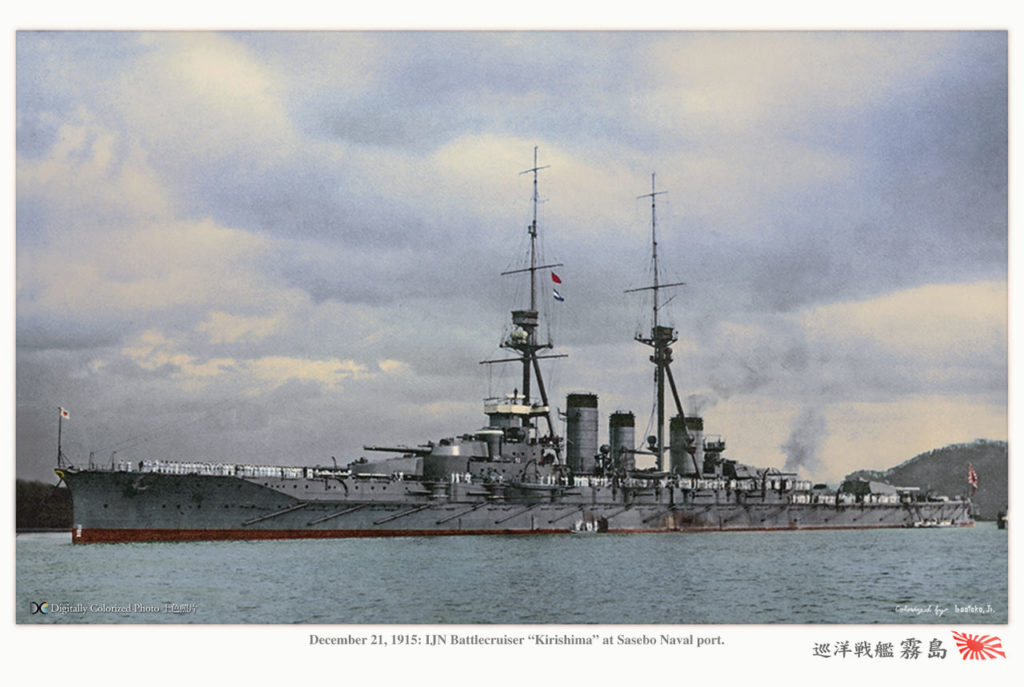
IJN Shikishima at Sasebo in 1915

Author’s illustration of the IJN Kongo class
Specifications
Displacement: 27,500 tonne standard 31,000 tonnes FL
Dimensions: 204.70 x 27 x 8.2 m ()
Propulsion: 4 shaft Brown-Curtis turbines, 24 Miyabara boilers, 40,000 hp, 27 Knots.
Armor: Deck 50, blockhouse 230, belt 210, turrets, 305 and 150, barbettes 152
Crew: 1210
Armament: 8 x 356 (15 in), 16 x 152 (6 in), 4 x 78 mm AA (3.5 in), 6 x 533 mm TT SM (21 in).
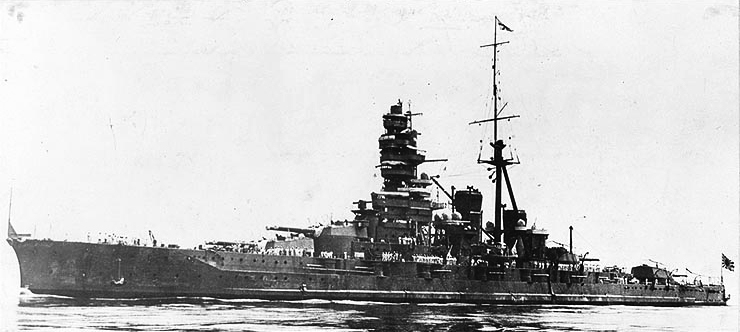
Kongo after her first major reconstruction in 1929
 Amagi class battlecruisers (1920)
Amagi class battlecruisers (1920)
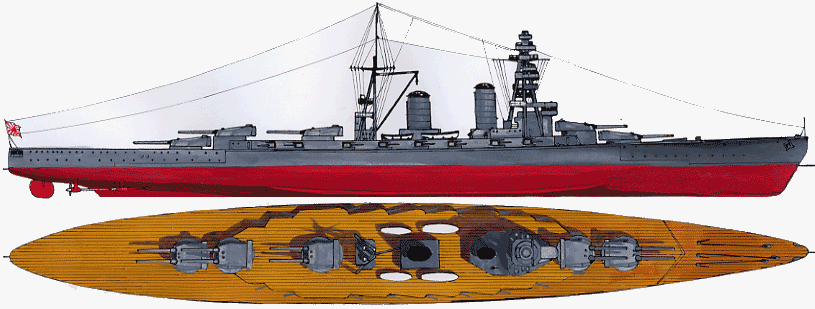
Author’s rendition of the IJN Amagi class

The Amagi class was a series of four battlecruisers, part of the ‘Eight-eight’ and planned successors of the Kongo class, named Amagi, Akagi, Atago, and Takao. The design was just a lengthened version of the Tosa-class seen earlier, with thinner belt, deck, and a much more powerful propulsion for 30 knots (56 km/h; 35 mph) while the secondary armament was rearranged, but the main battery was the same five twin turrets 41 cm (16.1 in) developed for the Nagato. The plan for one battleship construction (Nagato) was approved in 1917, along with funding for two battlecruisers, the Amagi class. By late 1917, the programme was renamed ‘eight-four plan’ and two more battlecruisers were approved, sister-ships of the Amagi-class. All had the same 410 mm (16 in) guns, but the effort put an immense financial strain on Japan, amounting to one third of its entire national budget. To put things in perspective, most European nations today barely spent 1% on their GDP on all three branches of defense.
The 1922 Washington Naval Treaty prevented their completion but authorization came to convert at least one of these into an aircraft carrier. At the origin, both the Amagi and Akagi were planned for conversion, but great Kanto earthquake damaged the Amagi hull in such a way there was no point on going further and she was scrapped. Meanwhile IJN Akagi reconstruction proceeded forward until 1927. She was part of the “Kido Butai”, the elite IJN carrier division but was lost at Midway.
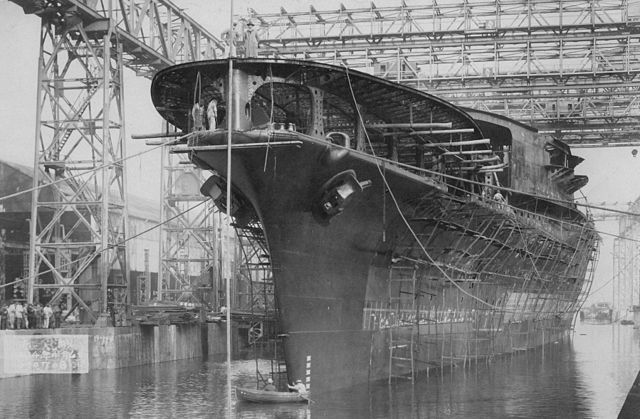
Prow of the IJN Akagi being launched in 1925, already converted. Reconstructions would go on for most of the interwar.
Specifications
Displacement: 27,500 tonne standard 31,000 tonnes FL
Dimensions: 204.70 x 27 x 8.2 m ()
Propulsion: 4 shaft Brown-Curtis turbines, 24 Miyabara boilers, 40,000 hp, 27 Knots.
Armor: Deck 50, blockhouse 230, belt 210, turrets, 305 and 150, barbettes 152
Crew: 1210
Armament: 10 x 410 (16 in), 16 x 140 (5.5 in), 4 x 78 mm AA (3.5 in), 6 x 533 mm TT SM (21 in).
Read More
Conway’s all the world’s fighting ships 1865-1905, 1906-1921
http://fr.naval-encyclopedia.com/1ere-guerre-mondiale/navires-japonais1914.php#cuirasses
en.wikipedia.org/wiki/Tosa-class_battleship
en.wikipedia.org/wiki/Number_13-class_battleship
en.wikipedia.org/wiki/Amagi-class_battlecruiser



 Latest Facebook Entry -
Latest Facebook Entry -  X(Tweeter) Naval Encyclopedia's deck archive
X(Tweeter) Naval Encyclopedia's deck archive Instagram (@navalencyc)
Instagram (@navalencyc)





 French Navy
French Navy Royal Navy
Royal Navy Russian Navy
Russian Navy Armada Espanola
Armada Espanola Austrian Navy
Austrian Navy K.u.K. Kriegsmarine
K.u.K. Kriegsmarine Dansk Marine
Dansk Marine Nautiko Hellenon
Nautiko Hellenon Koninklije Marine 1870
Koninklije Marine 1870 Marinha do Brasil
Marinha do Brasil Osmanlı Donanması
Osmanlı Donanması Marina Do Peru
Marina Do Peru Marinha do Portugal
Marinha do Portugal Regia Marina 1870
Regia Marina 1870 Nihhon Kaigun 1870
Nihhon Kaigun 1870 Preußische Marine 1870
Preußische Marine 1870 Russkiy Flot 1870
Russkiy Flot 1870 Svenska marinen
Svenska marinen Søværnet
Søværnet Union Navy
Union Navy Confederate Navy
Confederate Navy Armada de Argentina
Armada de Argentina Imperial Chinese Navy
Imperial Chinese Navy Marinha do Portugal
Marinha do Portugal Mexico
Mexico Kaiserliche Marine
Kaiserliche Marine 1898 US Navy
1898 US Navy Sovietskiy Flot
Sovietskiy Flot Royal Canadian Navy
Royal Canadian Navy Royal Australian Navy
Royal Australian Navy RNZN Fleet
RNZN Fleet Chinese Navy 1937
Chinese Navy 1937 Kriegsmarine
Kriegsmarine Chilean Navy
Chilean Navy Danish Navy
Danish Navy Finnish Navy
Finnish Navy Hellenic Navy
Hellenic Navy Polish Navy
Polish Navy Romanian Navy
Romanian Navy Turkish Navy
Turkish Navy Royal Yugoslav Navy
Royal Yugoslav Navy Royal Thai Navy
Royal Thai Navy Minor Navies
Minor Navies Albania
Albania Austria
Austria Belgium
Belgium Columbia
Columbia Costa Rica
Costa Rica Cuba
Cuba Czechoslovakia
Czechoslovakia Dominican Republic
Dominican Republic Haiti
Haiti Hungary
Hungary Honduras
Honduras Estonia
Estonia Iceland
Iceland Eire
Eire Equador
Equador Iran
Iran Iraq
Iraq Latvia
Latvia Liberia
Liberia Lithuania
Lithuania Mandchukuo
Mandchukuo Morocco
Morocco Nicaragua
Nicaragua Persia
Persia San Salvador
San Salvador Sarawak
Sarawak Uruguay
Uruguay Venezuela
Venezuela Zanzibar
Zanzibar Warsaw Pact Navies
Warsaw Pact Navies Bulgaria
Bulgaria Hungary
Hungary

 Bundesmarine
Bundesmarine Dutch Navy
Dutch Navy Hellenic Navy
Hellenic Navy Marina Militare
Marina Militare Yugoslav Navy
Yugoslav Navy Chinese Navy
Chinese Navy Indian Navy
Indian Navy Indonesian Navy
Indonesian Navy JMSDF
JMSDF North Korean Navy
North Korean Navy Pakistani Navy
Pakistani Navy Philippines Navy
Philippines Navy ROKN
ROKN Rep. of Singapore Navy
Rep. of Singapore Navy Taiwanese Navy
Taiwanese Navy IDF Navy
IDF Navy Saudi Navy
Saudi Navy Royal New Zealand Navy
Royal New Zealand Navy Egyptian Navy
Egyptian Navy South African Navy
South African Navy






























 Ukrainian Navy
Ukrainian Navy dbodesign
dbodesign